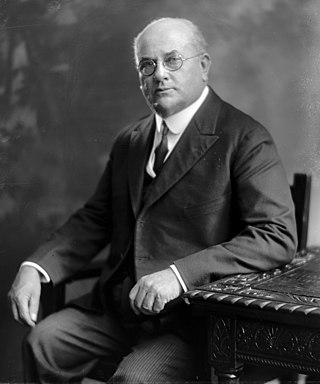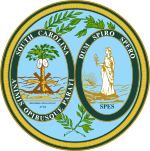
Thomas Gordon McLeod was an American attorney and the 95th Governor of South Carolina from 1923 to 1927.

The 1924 South Carolina gubernatorial election was held on November 4, 1924, to select the governor of the state of South Carolina. Governor Thomas Gordon McLeod won the Democratic primary and ran unopposed in the general election being reelected for a second two-year term.

The 1926 South Carolina gubernatorial election was held on November 2, 1926, to select the governor of the state of South Carolina. The South Carolina constitution was amended in 1926 to change the term of governor from two years to four years, but also prohibiting governors from consecutive terms. John Gardiner Richards, Jr. won the contested Democratic primary and ran unopposed in the general election becoming the 96th governor of South Carolina.

The 1930 South Carolina gubernatorial election was held on November 4, 1930, to select the governor of the state of South Carolina. Ibra Charles Blackwood won the contested Democratic primary and ran unopposed in the general election becoming the 97th governor of South Carolina.

The 1934 South Carolina gubernatorial election was held on November 6, 1934, to select the governor of the state of South Carolina. Olin D. Johnston won the contested Democratic primary and ran unopposed in the general election becoming the 98th governor of South Carolina.

The 1938 South Carolina gubernatorial election was held on November 8, 1938, to select the governor of the state of South Carolina. Burnet Rhett Maybank, Mayor of Charleston, South Carolina, won the contested Democratic primary and defeated Republican Joseph Augustis Tolbert in the general election becoming the 99th governor of South Carolina.

The 1942 South Carolina gubernatorial election was held on November 3, 1942, during World War II, to select the Governor of South Carolina. Olin D. Johnston won the Democratic primary and ran without opposition in the general election on account of South Carolina's effective status as a one-party state, winning a second non-consecutive term as Governor of South Carolina.

The 1946 South Carolina gubernatorial election was held on November 5, 1946 to select the governor of the state of South Carolina. Strom Thurmond won the contested Democratic primary and ran unopposed in the general election becoming the 103rd governor of South Carolina.

The 1950 South Carolina gubernatorial election was held on November 7, 1950, to select the governor of the state of South Carolina. James F. Byrnes won the Democratic primary and ran unopposed in the general election becoming the 104th governor of South Carolina.

The 1958 South Carolina gubernatorial election was held on November 4, 1958 to select the governor of the state of South Carolina. Ernest Hollings won the Democratic primary against rival Donald S. Russell and ran unopposed in the general election becoming the 106th governor.

The 1982 South Carolina gubernatorial election was held on November 2, 1982 to select the governor of the state of South Carolina. The state constitution was amended by the voters on November 4, 1980 to allow for the governor to serve a second consecutive four-year term. Governor Richard Riley, the popular Democratic incumbent, easily defeated Republican W. D. Workman, Jr. and became the first governor since Thomas Gordon McLeod in 1924 to be elected to a second consecutive term.

The 1908 South Carolina gubernatorial election was held on November 3, 1908, to select the governor of the state of South Carolina. Governor Martin Frederick Ansel faced state senator Coleman Livingston Blease in the Democratic primary and emerged victorious to win a second two-year term as governor.

The 1910 South Carolina gubernatorial election was held on November 8, 1910, to select the governor of the state of South Carolina. Coleman Livingston Blease won the Democratic primary and ran unopposed in the general election to become the 90th governor of South Carolina.
The 1912 South Carolina gubernatorial election was held on November 5, 1912, to select the governor of the state of South Carolina. Governor Coleman Livingston Blease won the Democratic primary. As South Carolina was utterly dominated by the Democratic Party, he faced no significant opposition in the general election.

The 1914 South Carolina gubernatorial election was held on November 3, 1914, to select the governor of the state of South Carolina. Richard Irvine Manning III emerged from the crowded Democratic primary to win in the runoff and overwhelmingly won the effectively one-party state's general election to become the 92nd governor of South Carolina.

The 1916 South Carolina gubernatorial election was held on November 7, 1916, to select the governor of the state of South Carolina. Governor Richard Irvine Manning III faced a strong challenge from former governor Coleman Livingston Blease in the Democratic primary, but Manning won a second two-year term as governor.

The 1914 United States Senate election in South Carolina was held on November 3, 1914, to select the U.S. Senator from the state of South Carolina. It was the first election in South Carolina in which the voters were able to choose the candidate in the general election. Incumbent Democratic Senator Ellison D. Smith won the Democratic primary and defeated nominal opposition in the general election to win another six-year term.

The 1930 South Carolina United States Senate election was held on November 4, 1930, to select the U.S. Senator from the state of South Carolina. Incumbent Democratic Senator Coleman Livingston Blease was defeated in the Democratic primary by James F. Byrnes. He was unopposed in the general election to win a six-year term.

The 1942 South Carolina United States Senate election was held on November 3, 1942 to select the U.S. Senator from the state of South Carolina. Incumbent Senator Burnet R. Maybank defeated Eugene S. Blease in the Democratic primary and was unopposed in the general election to win a six-year term.

The 1918 South Carolina United States Senate election was held on Tuesday, November 5, simultaneously with the special senate election to elect the United States Senator for a six-year term from South Carolina. Nathaniel B. Dial won the Democratic primary and was unopposed in the general election to win the six-year term to the Senate.














